Types of Arborvitae: Hedges, Trees, and Shrubs (With Pictures and Identification)
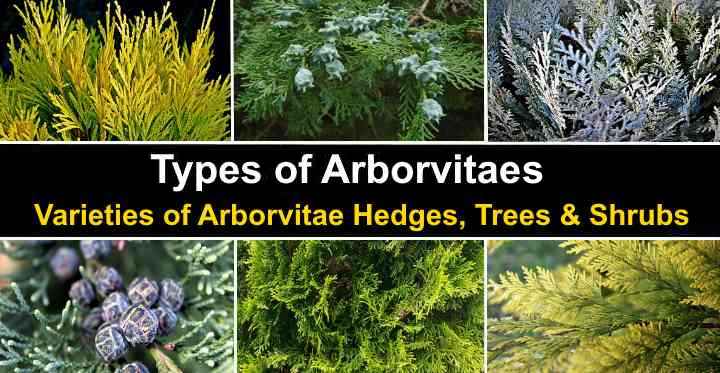
Arborvitaes are generally slow-growing evergreen conifers with soft, lush feathery foliage. Different types of arborvitae grow as upright columnar trees, small conical trees, or globe-shaped shrubs. Arborvitae trees and shrubs are ideal for natural privacy screens, wide hedges, living fences, or specimen trees.
Types of Arborvitae Trees
The five species of arborvitae trees (Thuja) are:
- American arborvitae or Eastern arborvitae (Thuja occidentalis)
- Giant arborvitae (Thuja plicata)
- Korean arborvitae (Thuja koraiensis)
- Japanese arborvitae (Thuja standishii)
- Sichuan Arborvitae (Thuja sutchuenensis)
Two species – American arborvitae and Giant arborvitae are native to North America, where they are popular garden landscaping plants. Their dense green foliage and fast growth make arborvitaes versatile plants that grow under various conditions.
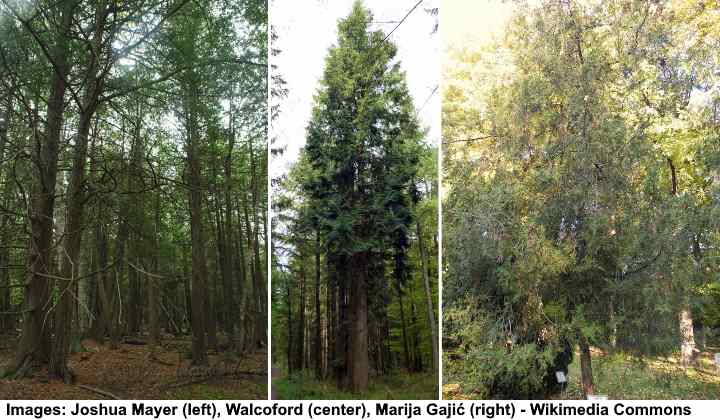
Three types of arborvitae: Thuja occidentalis (left), Thuja plicata (center) and Thuja orientalis (right). Each type has various cultivars.
The two main types of arborvitae that are common in North America are:
- American arborvitae (Thuja occidentalis). The American or eastern arborvitae is a popular garden landscape plant. In residential gardens, eastern arborvitaes thrive in well-draining soil and full sun. American arborvitae are cold-hardy plants that have green, greenish-yellow, or bronze foliage. American arborvitae can grow to a height of 49 ft. (15 m) tall, however small cultivars have developed to suit smaller spaces.
- Giant arborvitae (Thuja plicata). The giant arborvitae, or western red cedar, is a colossal conifer tree. Some dwarf western arborvitae species are perfect for front or backyards. The giant arborvitae has a conical shape with lush, evergreen foliage.
Sometimes trees from the genera Platycladus orientalis or Thuja orientalis are called Oriental arborvitae. The Oriental arborvitae is a slow-growing tree that can reach a height of 49–66 ft. (15–20 m) and has light green foliage. This evergreen conifer is ideal for formal or informal hedges and doesn’t lose its color throughout the year. Several small cultivars have been developed such as ‘Aura Nana’.
This article is a complete guide to the most popular types of arborvitaes. Descriptions of Thuja trees and pictures will help you choose the best arborvitaes for your garden landscape.
Types of Arborvitae (With Pictures) – Identification Guide
Most varieties of arborvitae are cultivars of the species Thuja occidentalis (American arborvitae). Most American arborvitaes grow in full sun and moist, well-draining soil.
Depending on the arborvitae species, the dense evergreen foliage grows as cone shapes, upright columns, or rounded shrubs. Small arborvitaes are ideal for foundation plantings, borders, hedges, and privacy screens.
Some arborvitae trees (Thuja) are also named cedar trees, however they are not true cedars as they are in the category of false cedar trees.
Here are descriptions and pictures of the most common arborvitae shrubs and trees.
American Arborvitae (Thuja occidentalis)
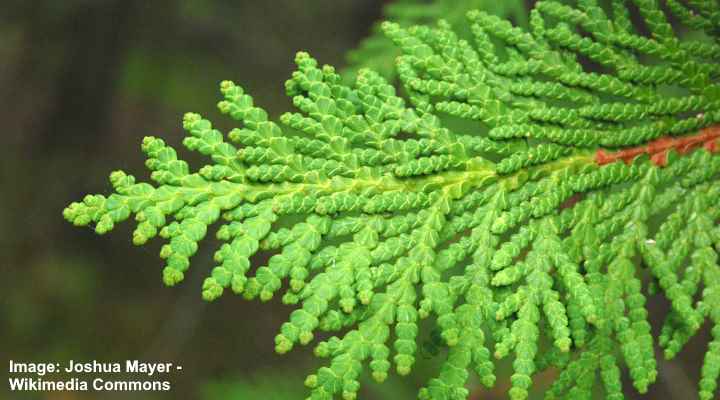
Thuja occidentalis foliage
American arborvitae is one of the best garden landscape plants. In its natural habitat, American arborvitaes are medium-sized trees, growing up to 50 ft. (15 m). Smaller cultivars of American arborvitae are popular as ornamental trees for hedges in residential gardens and parks.
Other names for American arborvitae include northern white cedar, swamp cedar, eastern arborvitae, and eastern white cedar.
Thuja occidentalis has scaly leaves that grow on fan-like branches. The flat scale-like leaves create dense foliage, especially when growing in full sun. The American arborvitae species has red-brown bark with furrows and plates that peel. American arborvitae cultivars can have a pyramidal, columnar, rounded, or straight skinny shape.
Information about growing American arborvitaes:
- USDA zones 2 – 7
- Grows up to 50 ft. (15 m)
- Thrives in full sun
Arborvitae ‘Emerald Green’ (Thuja occidentalis ‘Smaragd’)
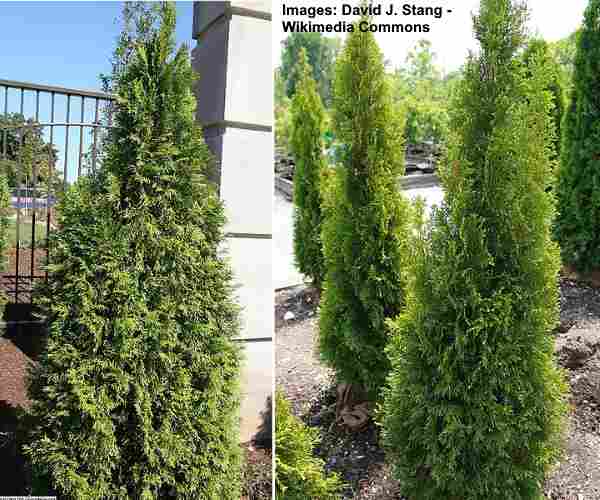
Pictures of Thuja ’emerald green’ (‘Smaragd’) – it’s considered as one of the best evergreen trees for privacy. It’s also one of the most beautiful types of columnar trees
The ‘Emerald Green’ arborvitae is one of the most popular landscaping trees in the Thuja species. Also called ‘Smaragd,’ this upright columnar arborvitae has compact growth and reaches up to 14 ft. (4 m) tall. The evergreen conifer keeps its color throughout the year and doesn’t turn bronze in winter.
‘Smaragd’ arborvitaes are slow-growing landscape trees. Plant the trees together to create a dense privacy hedge in full sun. ‘Emerald Green’ arborvitaes are ideal foundation plants, shrub borders, windbreaks, or living fences.
Information about growing ‘Emerald Green’ arborvitaes:
- USDA zones 2 – 7
- Grows to between 12 and 14 ft. (3.5 – 4 m)
- Low-maintenance columnar arborvitae
‘Little Giant’ Arborvitae (Thuja occidentalis ‘Little Giant’)
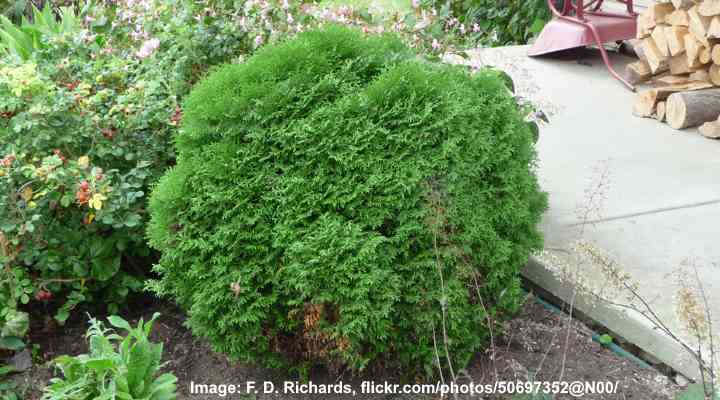
‘Little Giant’ cultivar is a dwarf arborvitae that is great for landscaped gardens
The ‘Little Giant’ arborvitae is a dwarf, globe-shaped conifer. This small arborvitae has rich green needle-like leaves that stay dark green all year long. As the arborvitae grows slowly, it develops into a perfect round ball. This easy-grow Thuja doesn’t require any pruning or trimming to keep its shape.
‘Little Giant’ dwarf arborvitaes grow to between 4 and 5 ft. (1.2 – 1.5 m). The slow-growing conifer is perfect as a foundation plant, low-growing formal hedge, or a specimen plant. Its rounded growth contrasts nicely with other tall skinny arborvitaes or pyramidal arborvitaes.
Information about growing ‘Little Giant’ arborvitaes:
- USDA zones 3 – 8
- Height: 5 ft. (1.5 m)
- One of the best round arborvitaes for garden landscapes
Thuja occidentalis ‘Hetz Midget’

‘Hetz Midget’ cultivar is one of the smallest arborvitae shrubs and can suit compact spaces
The ‘Hetz Midget’ arborvitae is a round dwarf arborvitae shrub. The ‘Hetz Midget’ arborvitae’s attractive feature is its dark green foliage that turns into hues of bronze in the winter. The flat leaves are scale-like and grow in fan-shaped clusters. Grow ‘Hetz Midgets’ in full sun or partial shade.
Being one of the shortest arborvitae shrubs, the ‘Hetz Midget’ is best for foundation plantings, mixed borders, miniature hedges, or rock gardens. This dwarf Thuja is also perfect as a container plant on terraces, patios, or porches.
Information about growing ‘Hetz Midget’ arborvitaes:
- USDA zones 3 – 7
- Height: 3 or 4 ft. (1 – 1.2 m)
- Small compact rounded arborvitae with bluish-green leaves
Thuja occidentalis ‘Fire Chief’
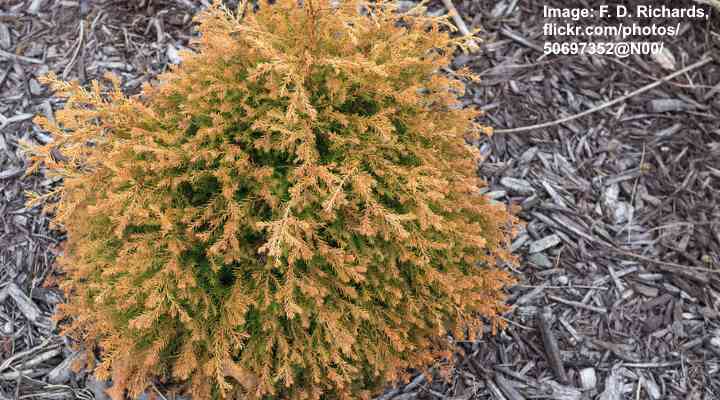
‘Fire Chief’ is an attractive dwarf arborvitae that changes its foliage color with the seasons
The ‘Fire Chief’ arborvitae is a small coniferous shrub with greenish-red foliage. The ‘Fire Chief’ Thuja is one of the most distinctive arborvitaes with its dense feathery foliage that changes with the seasons. Leaves are bright gold in spring, then dark green in summer before developing red tips in winter.
‘Fire Chief’ arborvitae shrubs are best growing as a foundation plant, low-growing hedge, or shrub border. As with most dwarf arborvitaes, the ‘Fire Chief’ also grows well in containers on your patio or balcony.
Information about growing ‘Fire Chief’ arborvitaes:
- USDA zones 5 – 7
- Height: 3 or 4 ft. (1 – 1.2 m)
- A globose, shrubby conifer with red fall and winter foliage
Thuja occidentalis ‘Aurea Nana’
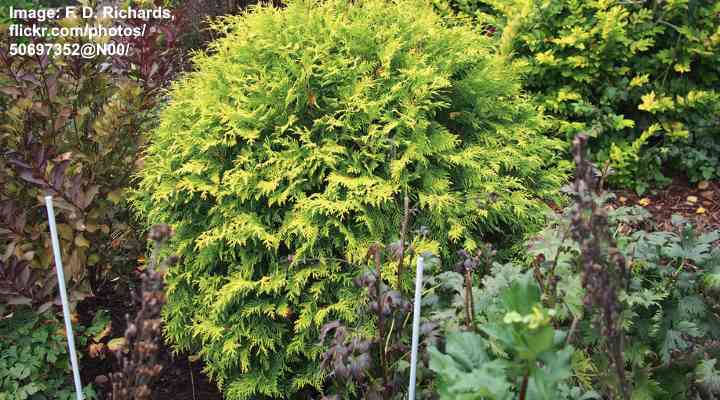
‘Aurea Nana’ is a decorative globe-shaped dwarf arborvitae with golden green foliage
Also called the Berkman’s Gold, the ‘Aurea Nana’ arborvitae is a delightful globe-like, spherical small conifer. The sun-loving arborvitae has bright golden-green foliage made up of soft needle-like leaves. In fall and winter, the evergreen foliage takes on an orangey-yellow color. This dwarf globe arborvitae is a drought-tolerant plant.
The ‘Aurea Nana’ arborvitae grows up to 6 ft. (1.8 m). However, it takes many years to reach this height. Grow ‘Aurea Nana’ as a foundation planting, specimen shrub, or formal low-growing hedge.
Information about growing ‘Aurea Nana’ arborvitaes:
- USDA zones 6 – 8
- Height: up to 6 ft. (1.8 m)
- Bright green foliage adds year-long color to garden landscapes
American Arborvitae ‘Yellow Ribbon’ (Thuja occidentalis ‘Yellow Ribbon’)
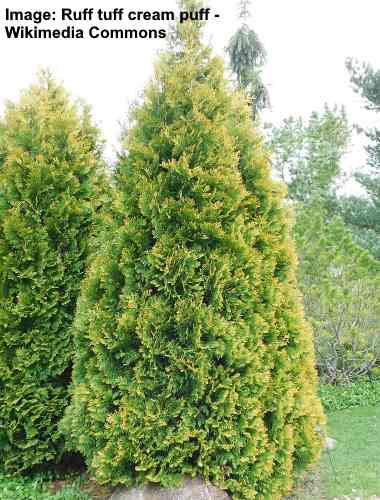
The ornamental ‘Yellow Ribbon’ arborvitae has narrow pyramidal shape and is great as a screening hedge
The ‘Yellow Ribbon’ arborvitae is a slow-growing, semi-dwarf conifer. This columnar arborvitae has upright growth and a narrow pyramidal shape. Its foliage has a yellowish-green color in spring before turning medium green, then reddish-brown. The yellow arborvitae’s color brightens up gardens throughout the year.
The tall arborvitae, ‘Yellow Ribbon,’ is best growing as a privacy screen or tall hedge. ‘Yellow Ribbon’ arborvitae cultivars grow to between 8 and 10 ft. (2.4 – 3 m) tall. The hedge plants have a spread of 3 ft. (1 m).
Information about growing ‘Yellow Ribbon’ arborvitaes:
- USDA zones 2 – 7
- Height: 8 to 10 ft. (2.4 – 3 m)
- Narrow, pyramid-shaped arborvitae with bright yellow-green foliage
Weeping Eastern Arborvitae (Thuja occidentalis ‘Pendula’)
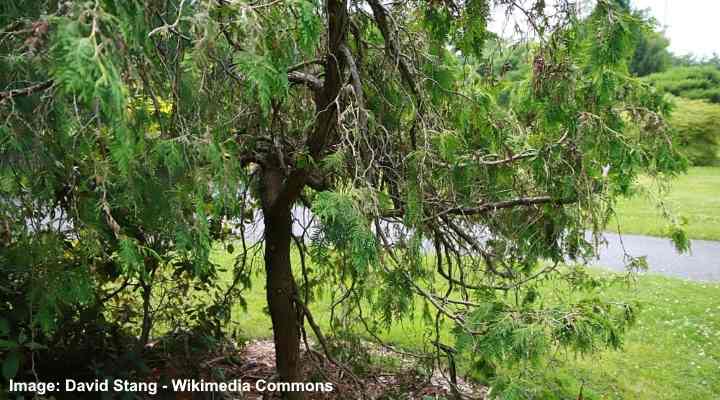
The weeping nature of Thuja occidentalis ‘Pendula’ makes it one of the best specimen arborvitae trees in the garden
The Weeping Eastern Arborvitae (Thuja ‘Pendula’) has drooping, pendulous leaves giving the conifer tree a weeping look. The weeping American arborvitae is one of the most unusual evergreen trees. The slow-growing Thuja will grow upright if the central stem is staked. Otherwise, the shrubby conifer has a spreading growth habit.
Due to its arching branches, the weeping eastern arborvitae grows best as a specimen tree. This rare weeping arborvitae will look like a spectacular ornamental tree in your front or backyard.
Information about growing weeping eastern arborvitaes:
- USDA zones 3 – 7
- Height: 5 to 10 ft. (1.5 – 3 m) after ten years
- The arborvitae has weeping growth and medium green foliage
‘Danica’ Globe Arborvitae (Thuja occidentalis ‘Danica’)
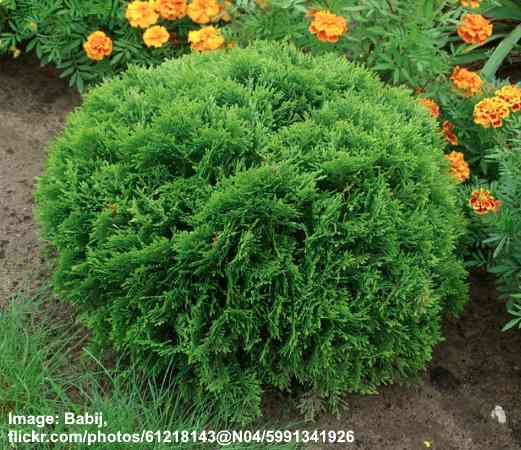
‘Danica’ cultivar is a miniature globe-shaped arborvitae shrub great for mixed borders
The ‘Danica’ arborvitae is one of the smallest globe arborvitaes. This miniature American arborvitae cultivar only reaches 2 ft. (0.6 m) tall and the same width. The arborvitae ‘Danica’ has green foliage that turns bluish-green in winter. Its dense scale-like leaves grow in a spherical or globe shape.
Small globe arborvitaes such as the ‘Danica’ cultivar are best planted as border shrubs, foundation plantings, or evergreen edging plants. The emerald green arborvitae foliage keeps its color all year and develops a bronze tinge in winter.
Information about growing ‘Danica’ arborvitaes:
- USDA zones 3 – 7
- Height: 1 to 2 ft. (0.3 – 0.6 m)
- Petite arborvitae that grows as a perfect sphere
‘Woodward’ Globe Arborvitae (Thuja occidentalis ‘Woodwardii’)

Thuja ‘Woodwardii’ has gray-green foliage that turns a pale green color in the winter
The Thuja ‘Woodwardii’ is a round arborvitae bush and one of the best hedge plants. Woodward arborvitaes have a globular-spreading growth habit. In ten years, the arborvitae ‘Woodwardii’ grows to between 4 and 5 ft. (1.2 – 1.5 m) is 8 ft. (2.4 m) wide. The low-maintenance arborvitae stays globular without pruning.
Grow Woodward arborvitae shrubs as a wide evergreen hedge. Because the arborvitae grows slowly, you can also grow it as a foundation plant, boundary plant, or specimen conifer.
Information about growing ‘Woodwardii’ arborvitaes:
- USDA zones 3 – 7
- Height: 4 to 10 ft. (1.2 – 3 m)
- Easy care rounded arborvitae
Rheingold Arborvitae (Thuja occidentalis ‘Rheingold’)
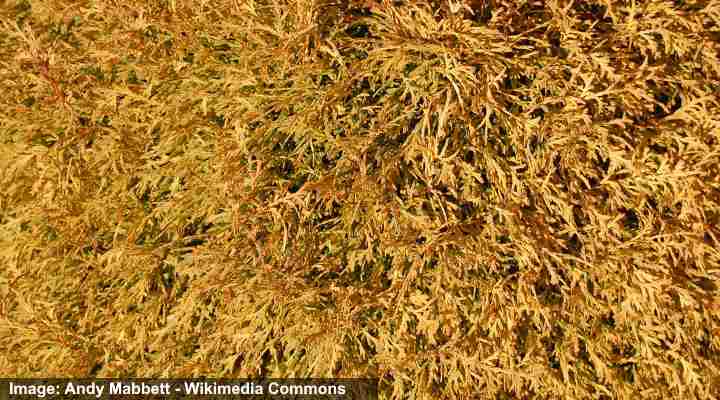
Thuja occidentalis ‘Rheingold’ shrub with golden foliage in autumn
The ‘Rheingold’ cultivar is a variety of yellow arborvitae with a dome shape and bright golden leaves. This slow-growing arborvitae reaches heights between 3 and 5 ft. (1 – 1.5 m). Some varieties have a rounded shape, whereas other ‘Rheingold’ arborvitaes are cone-shaped.
‘Rheingold’ arborvitaes are an ideal choice for a foundation plant, border plant, or low privacy hedge. Grow in moist soil and full sun to keep the yellow foliage bright and dense.
Information about growing ‘Rheingold’ arborvitaes:
- USDA zones 4 – 8
- Height: up to 5 ft. (1.5 m)
- An arborvitae with bright, golden-yellow foliage and a bushy growth
‘North Pole’ Arborvitae (Thuja occidentalis ‘North Pole’)

The narrow ornamental ‘North Pole’ arborvitae is also called ‘Art Boe’ thuja
‘North Pole’ arborvitaes are upright columnar conifers with dark evergreen foliage. ‘North Pole’ cultivars are slow-growing ornamental arborvitaes that grow to between 4 and 6 ft. (1.2 – 1.8 m) tall. The majestic arborvitae has narrow growth that is ideal for vertical accent in any garden landscape.
Also called the ‘Art Boe’ arborvitae, this cold-hardy shrub is the perfect choice for growing tall hedgerows, privacy screens, or borders. The skinny arborvitae also makes an excellent specimen tree in small gardens.
Information about growing ‘Rheingold’ arborvitaes:
- USDA zones 3 – 7
- Height: 4 to 6 ft. (1.2 – 1.8 m)
- Medium-sized arborvitae with dark green soft foliage
Arborvitae ‘Filips Magic Moment’ (Thuja occidentalis ‘Filips Magic Moment’)
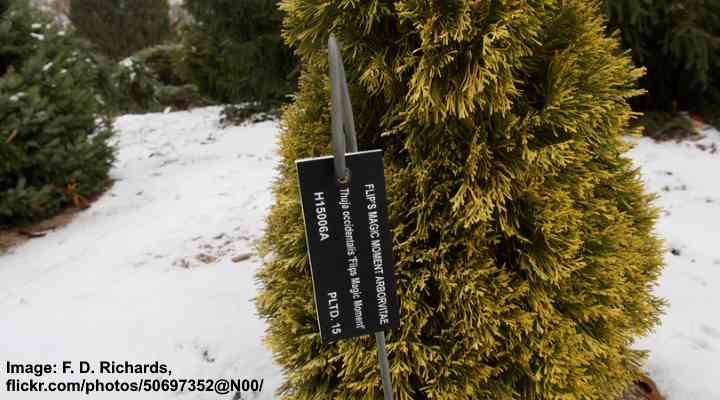
The hardy ‘Filips Magic Moment’ arborvitae has an upright pyramidal growth with golden colored foliage
The ‘Filips Magic Moment’ is a yellow arborvitae that keeps its golden color in the heat and cold. This hardy arborvitae has an upright narrow growth. Golden-yellow scaly soft foliage form its columnar pyramid shape. The ‘Filips Magic Moment’ arborvitae is an excellent choice to brighten up garden landscapes.
The easy-grow Filips Magic Moment arborvitae grows best in full sun and moist soil. Plant the arborvitaes in a row to create a bright yellow hedge, natural privacy screen, or living fence. You can also add ‘Filips Magic Moment’ cultivars as a corner planting or entrance container plant.
Information about growing ‘Filips Magic Moment’ arborvitaes:
- USDA zones 3 – 7
- Height: 6 to 8 ft. (1.8 – 2.4 m)
- Yellow columnar arborvitae
Oriental Arborvitae (Platycladus orientalis or Thuja orientalis)

Pictures of mature oriental arborvitae trees
The Oriental arborvitae is an evergreen conifer native to Asia that can reach height of 49–66 ft. (15–20 m). Dwarf Oriental arborvitae cultivars have a rounded growth with brightly-colored foliage that turns bronze in winter. Cultivars in the genus Platycladus orientalis belong to the cypress family.
Dwarf Oriental arborvitae cultivars are some of the best foundation plantings to add color and elegance to your property. You can also grow oriental arborvitaes as a low hedge, border plant, or specimen shrub.
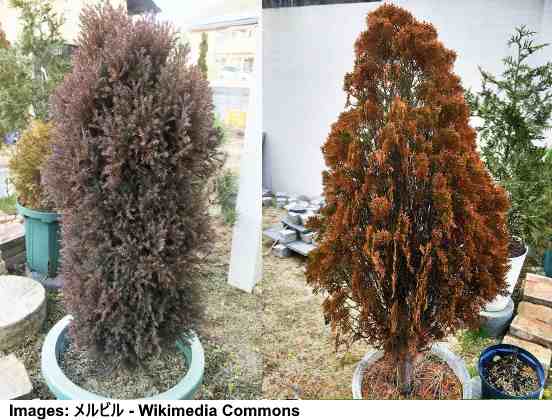
Dwarf cultivars of oriental thuja: ‘Rosedalis’ (left) and ‘Semperaurea’ in winter
Information about growing Oriental arborvitaes:
- USDA zones 6 – 9
- Height: 2 to 5 ft. for dwarf cultivars (0.6 – 1.5 m)
- Rounded arborvitae cultivar, perfect for residential garden landscapes
Western Red Cedar ‘Green Giant’ (Thuja plicata ‘Green Giant’)
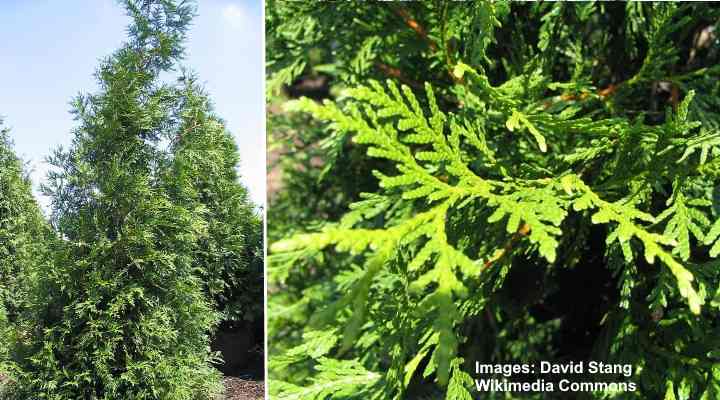
Thuja plicata ‘Green Giant’ can grow to a very tall tree but there are smaller cultivars to suit residential gardens
The western red cedar or western arborvitae is a huge evergreen conifer. These giant arborvitaes are rarely used for residential landscapes. Western arborvitaes grow to between 210 and 230 ft. (64 – 70 m). These impressive arborvitaes have green foliage in the form of flat needle-like foliage.
Small Western red arborvitae cultivars are ornamental trees that are excellent choices for hedges in residential gardens. Some of the best western arborvitae cultivars for front or backyards are ‘Atrovirens,’ ‘Stoneham Gold,’ ‘Aurea,’ and ‘Whipcord.’

Thuja plicata ‘Whipcord’ shrub has drooping whipcord-like foliage and can each 4-5 feet (1.2-1.5 m) tall
Western Arborvitae ‘Zebrina’ (Thuja Plicata ‘Zebrina’)
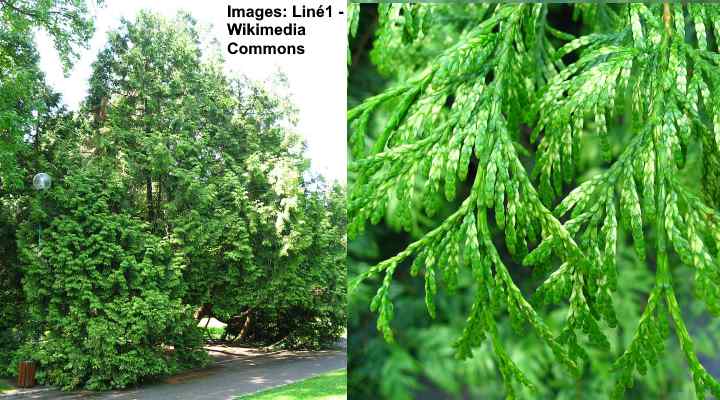
The ‘Zebrina’ arborvitae is a variegated evergreen conifer with unusual foliage. As its cultivar name suggests, the ‘Zebrina’ arborvitae has green foliage with creamy-yellow zebra-like stripes or markings. The fast-growing cypress tree grows up to 40 ft. (14 m) at maturity and has an annual growth rate of 1 ft. (30 cm).
‘Zebrina’ arborvitae trees have a conical upright shape. The medium-sized arborvitaes are best growing as tall informal hedges. With regular pruning, you can also grow medium-sized privacy screens for your backyard.
Related articles:
